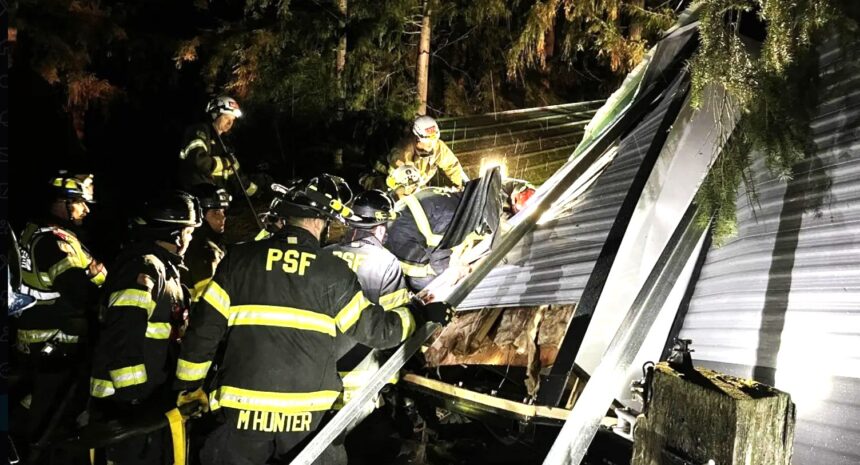Bomb Cyclone Slams the Pacific Northwest, Causing Destruction
A powerful bomb cyclone that struck the Pacific Northwest and British Columbia has left a trail of devastation, with widespread power outages, fallen trees, and tragic fatalities. This rare storm brought hurricane-force winds, heavy rainfall, and the threat of life-threatening flooding, severely impacting communities across the region. As the storm moves east, its effects continue to pose significant risks, with flooding and heavy snow expected to follow in the coming days.
Powerful Winds and Destruction
The bomb cyclone brought fierce, hurricane-force winds to the Pacific Northwest, with gusts reaching up to 77 mph in parts of Washington state. These winds, combined with heavy rainfall, caused widespread damage. In Washington, over 500,000 homes and businesses were left without power early on Wednesday, with additional outages reported in British Columbia, where nearly 100,000 customers were affected.
Seattle was among the hardest-hit areas, where fallen trees and power lines blocked streets and damaged homes. Puget Sound Energy reported that more than 450,000 customers in the Seattle area lost power due to the storm, in what was called a “mass outage event.” Emergency services in Bellevue, Washington, warned of dangerous conditions, urging residents to stay indoors and away from windows due to falling trees and debris.
Whoahh! This is Bellevue in Washington. A bomb cyclone is wreaking havoc in the northwest U.S. and Canada, toppling trees and cutting power to hundreds of thousands. One death reported.pic.twitter.com/5Zg8MFBHCf
— Volcaholic 🌋 (@volcaholic1) November 20, 2024Fatalities and Emergency Responses
The storm claimed at least one life when a woman in her 50s was killed in Lynnwood, Washington, after a large tree fell on a homeless encampment Tuesday evening. Rescue teams were quick to respond, but the storm’s severe conditions made it difficult to reach those in need of help. In Seattle, a tree fell on a vehicle, trapping the driver inside, but emergency personnel were able to free the individual, who was later reported to be in stable condition.
One resident in Issaquah, Washington, described hearing a loud crash when a 70-year-old tree fell on her home, shaking the structure. Despite the intense noise and damage, the resident was uninjured. However, the destructive nature of the storm left many residents shaken, with emergency responders working tirelessly to manage the aftermath of fallen trees and power outages.
Bomb Cyclone 🌀 in Pacific Northwest.
Here in Washington State:
Seattle and Bellevue⤵️
Winds up to 70 mph. pic.twitter.com/ZP23fQirhA
— Light Beings Observer (@BeingsObserver) November 20, 2024Flooding Risks from Atmospheric River
As the storm’s winds begin to subside, a new threat emerges in the form of an atmospheric river, a concentrated plume of moisture that is combining with the remnants of the bomb cyclone. This atmospheric river is expected to bring intense rainfall, which could lead to life-threatening flooding across parts of the West Coast, including northern California, Oregon, and Washington. The Weather Prediction Center has issued warnings for excessive rainfall through Friday, with rainfall amounts of up to 16 inches expected in some areas.
This heavy rainfall is likely to cause flash floods, rockslides, and debris flows, particularly in regions already weakened by high winds and fallen trees. Forecasters are especially concerned about areas with steep terrain, where rapid runoff could overwhelm rivers and streams, creating dangerous conditions. The National Weather Service has urged residents to stay alert and prepare for possible evacuations in flood-prone regions.
Snow and Winter Weather Hazards
In addition to the flooding threat, the storm is bringing heavy snow to higher elevations in the Cascades and northern California. Blizzard warnings have been issued for areas like Mount Rainier, where snow accumulation rates could reach up to 3 inches per hour. Winds of up to 65 mph are expected in mountainous regions, creating near whiteout conditions and making travel nearly impossible across mountain passes.
Heavy snow is also expected in northern California’s Sierra Nevada, with up to a foot of snow forecast in some areas. Strong winds and snow will also affect parts of the San Francisco Bay Area and Sacramento Valley, creating hazardous travel conditions. Winter storm warnings have been issued for these areas, urging travelers to avoid mountain routes and stay off the roads unless absolutely necessary.
Ongoing Warnings and Safety Measures
As the storm continues to impact the West Coast, authorities are advising residents to stay indoors and avoid unnecessary travel. The National Weather Service has issued safety warnings about the dangers of high winds, urging people to avoid exterior rooms and stay away from windows. Fallen trees and debris are expected to continue causing hazards, and emergency teams are on high alert to respond to any new incidents.
Flash flood warnings remain in effect for parts of Washington, Oregon, and California, with significant rain and snow still on the way. Travel across mountain passes will be challenging, and emergency responders are warning that conditions could worsen before improving. Winter weather alerts remain in effect for the Sierra Nevada and Cascades, where snow and gusty winds will continue into Thursday.
The bomb cyclone that struck the Pacific Northwest has caused significant destruction, leaving hundreds of thousands without power and claiming lives. While the storm’s winds are beginning to calm, new threats such as flooding and heavy snow continue to pose risks across the West Coast. Residents are urged to stay vigilant, follow safety warnings, and prepare for further challenges as emergency crews work to restore power and assist those affected by the storm’s impact.
Read More : Howard Lutnick’s Surprise Nomination for Commerce Secretary Stuns Washington






